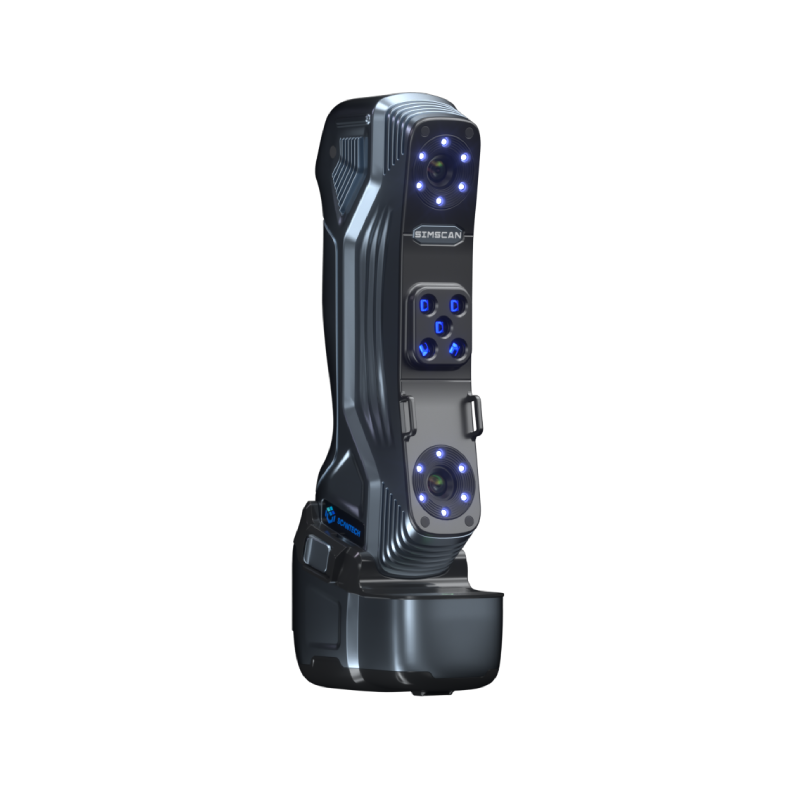What are 3D laser scanners used for?
05 Jun, 2025
The advent of 3D laser scanners has revolutionized the way industries capture and replicate intricate details of objects, enhancing the accuracy and efficiency of various processes. This advanced technology employs laser beams to analyze real-world objects and create data sets representing their exact dimensions and shape. A laser scanner works by projecting a laser beam onto an object and measuring the reflected light's time of flight or phase shift, building a detailed point cloud model. This non-contact metrology system offers unparalleled precision and versatility, making it indispensable across numerous sectors.
Industrial Applications of 3D Scanners
Manufacturing and Production
In the manufacturing realm, 3D laser scanners have become invaluable tools for improving product design and ensuring quality control. By accurately capturing the geometries of components, manufacturers can perform precise inspections and detect deviations from design specifications. This technology enhances the production process by providing critical data for adjustments and improvements. The integration of 3D scanning in production lines not only boosts efficiency but also minimizes waste and reduces the risk of costly errors.
Quality Control and Inspection
Quality assurance is fundamentally bolstered by 3D laser scanners, which offer high precision in measuring and analyzing product features. They are essential for ensuring compliance with stringent industry standards and regulations. By providing accurate dimensional analysis, these scanners help identify defects and imperfections, facilitating immediate corrective action. Their application spans automotive, aerospace, and other high-stakes industries where precision is crucial.
Automotive and Aerospace Innovation
Design Prototyping and Testing
In the automotive and aerospace industries, the precision of 3D laser scanners is crucial for prototyping and testing. Engineers rely on accurate digital models to assess design feasibility and performance under various conditions. This technology expedites the development process by allowing for rapid iterations and modifications based on detailed scan data. The ability to conduct virtual testing reduces the need for physical prototypes, saving time and resources.
Aerodynamic Modeling and Analysis
Aerodynamics is a key aspect of automotive and aerospace engineering, where even minor deviations can impact performance and safety. 3D laser scanners provide the precise data needed for aerodynamic analysis and optimization. These devices capture the intricate geometries of components, enabling engineers to simulate airflow and make informed design adjustments. The resulting enhancements in efficiency and performance underscore the importance of 3D scanning technology in these cutting-edge industries.
3D Scanners in Healthcare
Medical Imaging and Diagnostics
The healthcare industry has embraced 3D laser scanners for their unparalleled accuracy in medical imaging. These devices capture high-resolution images of anatomical structures, aiding in diagnostics and treatment planning. Surgeons rely on these detailed models for preoperative assessments, allowing for more precise surgical interventions. Furthermore, 3D scanning technology plays a crucial role in developing customized medical devices and prosthetics tailored to individual patients' needs.
Customized Prosthetics and Implants
Personalization is a cornerstone of modern healthcare, particularly in the development of prosthetics and implants. 3D laser scanners enable the creation of custom-fit devices by capturing the exact contours of a patient's body. This technology improves the comfort, functionality, and overall success of prosthetics and implants, enhancing patients' quality of life. The precise data captured allows for more efficient production processes and reduces the time required to deliver these critical medical solutions.
Uses in Archaeology and Heritage Conservation
Digitizing Historical Artifacts
Preserving cultural heritage is significantly enhanced by the use of 3D laser scanners. These devices enable the digital archiving of historical artifacts, creating detailed replicas without the risk of damaging delicate objects. This digital preservation ensures that future generations can access and study these artifacts without compromising their physical integrity. The ability to produce precise reproductions also aids in the education and dissemination of cultural history.
Preserving and Reconstructing Heritage Sites
Beyond artifact preservation, 3D laser scanners play a vital role in documenting and reconstructing heritage sites. The accuracy of 3D data ensures that conservation efforts are based on reliable measurements, facilitating the restoration of historical structures to their original state. This technology empowers archaeologists and conservationists to analyze and visualize sites in new ways, supporting efforts to maintain our global cultural heritage.
Entertainment and Media Production
Virtual Reality and Gaming
The entertainment industry harnesses the capabilities of 3D laser scanners to create immersive virtual experiences. In virtual reality (VR) and gaming, detailed 3D models bring environments and characters to life, enhancing user engagement and realism. The precision of laser scanning allows for the creation of lifelike avatars and intricate scenery, elevating the overall quality of digital content. This technology is integral to the development of next-generation entertainment platforms.
Film Special Effects and Animation
In film and animation, special effects rely heavily on the accuracy of 3D laser scanners. These devices capture real-world objects and textures with high fidelity, which are then integrated into digital scenes. The seamless blending of live-action and CGI is facilitated by precise 3D models, contributing to the visual impact of modern cinema. The creative possibilities unlocked by this technology continue to expand the boundaries of storytelling and visual artistry.
Advantages of 3D Laser Scanning
Precision and Accuracy in Data Capture
3D laser scanners are renowned for their ability to capture data with exceptional precision and accuracy. This capability is crucial across industries where precise measurements dictate success, from manufacturing to healthcare. The ability to generate detailed, high-resolution models ensures that every aspect of an object is accounted for, facilitating better decision-making and innovation.
Efficiency in Project Execution
Beyond accuracy, 3D laser scanners offer significant efficiency gains in project execution. The speed at which data is collected and processed minimizes downtime and accelerates workflows. This efficiency translates to cost savings, as projects can be completed faster and with fewer resources. The integration of laser scanning into various processes enhances overall productivity and competitiveness.
Considerations for Implementation
Investment and Expertise Requirements
While 3D laser scanners offer extensive benefits, adopting this advanced technology involves a certain level of investment and technical knowledge. High-performance scanners and professional-grade software represent a meaningful commitment, which may require careful planning—especially for smaller organizations. Additionally, to maximize the potential of 3D scanning, trained personnel are essential, which highlights the importance of skill development within teams.
Data Management Considerations
3D laser scanning generates detailed and comprehensive datasets, which call for effective processing and storage capabilities. To handle this valuable information efficiently, organizations may need to enhance their computing infrastructure and adopt reliable data management strategies. These efforts ensure the full value of the technology is realized in practical applications.
Future Trends in 3D Scanning Technology
Developments in Scanner Capabilities
The future of 3D laser scanning is marked by ongoing advancements in scanner capabilities. Improvements in resolution, speed, and portability are expanding the potential applications of this technology. As scanners become more sophisticated, they will offer enhanced accuracy and versatility, catering to a broader range of industry needs. The integration of new sensor technologies and algorithms promises to further refine the precision and usability of 3D scanning systems.
Integration with AI and Machine Learning
The integration of artificial intelligence (AI) and machine learning with 3D scanning technology is set to revolutionize data analysis and interpretation. By automating the processing of scan data, AI can identify patterns and insights that may elude human analysis. Machine learning algorithms can optimize scanning processes, improving efficiency and reducing errors. This convergence of technologies will drive innovation and unlock new possibilities for leveraging 3D data.
Conclusion
3D laser scanners are transforming industries by providing unparalleled precision and efficiency in data capture and analysis. Their applications span manufacturing, healthcare, heritage conservation, and entertainment, among others. As technology continues to evolve, the capabilities of 3D scanners will expand, unlocking new opportunities for innovation and growth.
What Sets Apart
What sets apart is its seamless integration of cutting-edge technology and craftsmanship, focusing on producing the most reliable industrial-grade products.
The company’s experienced engineering team works closely with clients to deeply understand project goals and develop solutions that meet industry demands.
The 3D scanners are not only user-friendly but are also calibrated before leaving the factory, ensuring that users can quickly perform high-precision 3D scans.
For example, the SIMSCAN is a palm-sized 3D scanner weighing just 570 grams, and equipped with a metrology-grade measurement system capable of capturing every detail and constructing 3D models swiftly.

The SIMSCAN, with its high frame rate and rapid data capture capabilities, delivers high-quality scans even in confined spaces like engine bays. Its design won the Red Dot Design Award in 2021, demonstrating its leadership in innovative design.
Additionally, produces a range of scanners for various applications and includes the 3D software
DefinSight, which provides real-time feedback during scanning and integrates into the product redesign process.
The 3DeVOK MQ 3D color scanner, is considered an ideal choice for body scanning. Meanwhile, the NimbleTrack wireless 3D scanning system, launched in April 2024, can scan objects of all sizes in any environment.

It tackles challenging scenarios such as field measurements of corroded oil pipelines or high-altitude scanning of large components.
The NimbleTrack can also be paired with the tracking i-Probe to probe hard-to-reach areas, making it a valuable tool in industrial applications.

























 All Products
All Products 











 en
en 


















